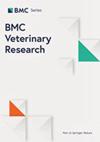基于尼罗罗非鱼(Oreochromis niloticus)组织病理学的研究,作为埃塞俄比亚塔纳湖南部海湾水污染评估的生物标志物
IF 2.3
2区 农林科学
Q1 VETERINARY SCIENCES
引用次数: 0
摘要
在过去十年中,人们观察到水生环境中的污染物分布越来越广,对鱼类造成了综合影响。同样,由于人为活动的影响,塔纳湖南部海湾也成为受影响地区,尼罗罗非鱼产量减少。因此,本研究的目的是在 2023 年 2 月至 2023 年 5 月期间,通过横断面研究,对塔纳湖南部海湾的 48 种尼罗罗非鱼的健康状况和水产养殖情况进行基于组织病理学的研究。该研究采用描述性统计和 2 × 2 或然率表及 t 检验分析,对鳃、肝脏、性腺和脾脏器官的组织病理学进行了评估。因此,在所有受检鱼类中,增生(54.15%)、色素沉积(52%)、出血(50%)和免疫细胞浸润(50%)分别是最常发现的病变。然而,来自塔纳湖南部海湾的尼罗罗非鱼出现组织病理学改变的几率是来自水产养殖的尼罗罗非鱼的 1.4 倍(几率比),尽管在统计学上并不显著(P > 0.05)。此外,研究还发现鱼类指数的平均值(95.3)以及鳃(13.6)、肝(14.8)和性腺(12.3)的退行性指数;此外,脾脏器官的炎症指数(11.此外,塔纳湖南部海湾的脾脏炎症指数(11.3)以及鳃(2.35)和生殖腺(1.7)器官的平均严重程度等级值都明显高于水产养殖地(p < 0.05)。总体而言,与水产养殖相比,塔纳湖南部海湾的罗非鱼表现出更高的病理严重性。在评估的四个目标器官中,肝脏器官受损最严重,而性腺是受影响最小的器官。因此,结论是罗非鱼的生活条件不正常,为了确保渔业的可持续发展,必须适当关注 Bahirdar 市的水污染源,今后的研究应考虑年龄差异、季节变化和特定污染物的检测。本文章由计算机程序翻译,如有差异,请以英文原文为准。
Histopathology based study of Nile tilapia fish (Oreochromis niloticus) as a biomarker for water pollution evaluation in the southern gulf of Lake Tana, Ethiopia
In the past decade, the increasing distribution of pollutants in the aquatic environment has been observed, causing integrative effects on fish. Likewise, due to anthropogenic activities, the southern gulf of Lake Tana is an impacted region, and the production of Nile tilapia fish is reduced. For this reason, the aim of this study was to conduct a histopathological-based study of 48 Nile tilapia fishes’ health status at the southern gulf of Lake Tana and aquaculture using a cross-sectional study from February 2023 to May 2023. The study evaluated the histopathology of the gill, liver, gonads, and spleen organs using descriptive statistics accompanied by a 2 × 2 contingency table and t-test analysis. During the study, different histological alterations were detected, and the numbers of fish affected by a specific histological alteration were presented as percentage prevalence; hence, from the total fish examined, hyperplasia (54.15%), followed by pigment deposits (52%), hemorrhage (50%), and immune cell infiltration (50%), respectively, were the most frequently detected alterations. However, Nile tilapias from the southern gulf of Lake Tana were 1.4 (odds ratio) times more likely to show histopathological alterations than those from aquaculture, although statistically, was not significant (p > 0.05). In addition, the study found the mean value of the fish index (95.3) and regressive indices of the gill (13.6), liver (14.8), and gonad (12.3); moreover, the inflammatory indices of the spleen organ (11.3) and mean severity grade value of the gill (2.35) and gonad (1.7) organs, respectively, were obtained from the southern gulf of Lake Tana, and all those values were significantly higher (p < 0.05) from this site as compared to the aquaculture. In general, it has been found that tilapias from the southern gulf of Lake Tana showed higher pathological severity as compared with aquaculture. Among the four target organs evaluated, liver organs were observed to be the most damaged, while gonads were the least impacted organs. Therefore, it has been concluded that tilapia fish are living in abnormal conditions, so to ensure a sustainable fishery, water pollutant sources from Bahirdar city must receive proper attention, and future studies should consider age differences, seasonal variation, and the detection of specific pollutants.
求助全文
通过发布文献求助,成功后即可免费获取论文全文。
去求助
来源期刊

BMC Veterinary Research
VETERINARY SCIENCES-
CiteScore
4.80
自引率
3.80%
发文量
420
审稿时长
3-6 weeks
期刊介绍:
BMC Veterinary Research is an open access, peer-reviewed journal that considers articles on all aspects of veterinary science and medicine, including the epidemiology, diagnosis, prevention and treatment of medical conditions of domestic, companion, farm and wild animals, as well as the biomedical processes that underlie their health.
 求助内容:
求助内容: 应助结果提醒方式:
应助结果提醒方式:


